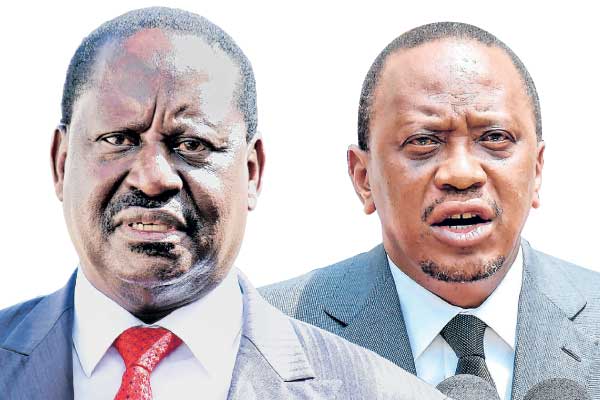Araweelo News Network

President Uhuru Kenyatta (right) and Nasa presidential candidate Raila Odinga. PHOTO | FILE | NATION MEDIA GROUP
Nairobi: They flipped and flopped – and flipped again. In an election that had no specific selling point or agenda, the two leading candidates, President Uhuru Kenyatta and former Prime Minister Raila Odinga, fought for survival in a race of 4 “Ps” – promises, personality, party, and policy, in that order.
Both ran frenzied campaigns and electrified their supporters with facts, slogans, music, lies, half-truths and fake news.
For his part, President Kenyatta’s campaign secretariat dished out hundreds of thousands of banners and T-shirts and run perhaps the best-branded presidential campaign in Kenya’s history.
Money, it seemed, was not a problem to the son of Kenya’s first President who was bankrolled by business heavyweights from the Mt Kenya region and family coffers.
For his part, the charismatic former Prime Minister, first elected as MP in 1992, used his agility to galvanise his supporters and despite the shortfall in funding – at times reaching out to voters to help – he ran his second best campaign ever since he started his determination to clinch the presidential seat. By far, pundits say, Raila’s 2007 campaign, which some say was stolen, remains his best.
To his credit, Raila fought off attempts by the government and its agents to dismantle the coalition and is credited for keeping the team of former Vice President Kalonzo Musyoka, and former Foreign Minister Moses Wetang’ula and for bringing on board former Vice-President Musalia Mudavadi and Bomet Governor Isaac Ruto to what became the Nasa coalition.
President Kenyatta was backed by his Deputy President William Ruto, who is aiming to vie for the seat in 2022 and was thus fighting to save his place as successor to the throne with a Kenyatta victory.
But it was lack of solid policy statements that was the hallmark of this campaign which was dominated by sideshows mostly directed at the electoral commission which was accused, mostly by Nasa, of siding with Jubilee. On its part, Jubilee always accused the Judiciary of backing Mr Odinga.
Nobody had a prescription on taxes and spending – and perhaps the electorate was not ready for it.
ECONOMIC ISSUES
With neither of the candidates engaging the other on solid economic issues, the 2017 presidential tussle was more of a clickbait campaign, and more of entertainment.
In between, the Jubilee Party defended and showcased its mega project – the Standard Gauge Railway and other infrastructure projects – as a sign of its first term efforts.
However, the Nasa coalition mocked the projects and claimed to have initiated them during the Grand Coalition government of Mwai Kibaki and Raila Odinga – and more so – it accused Jubilee of inflating the cost of the projects to line the pockets of its bureaucrats and tenderpreneurs.
While corruption was supposed to take a centre stage in this year’s campaign, the emergence of Kenya’s best-known tenderpreneur Jimi Wanjigi as the driving force behind the Nasa campaign kitty saw the coalition go slow on the anti-corruption theme – and Jubilee took advantage of that dismissing the coalition as financed by cartels.
PUBLIC DEBT
But more importantly – though not copiously addressed – was the rise of the overall public debt which increased by Sh608 billion in 12 months to Sh4 trillion, equivalent to 52.6 per cent of GDP according to latest data from the Treasury, and which sees the country spend Sh435.7 billion to settle debts in the 2016/17 financial year.
When President Kenyatta took over, Kenya had a total public debt of Sh1.89 trillion in June 2013, equivalent to 42 per cent of the GDP but the issue was not well canvassed by the opposition which failed to break down its meaning.
During the solo presidential debate attended by Mr Odinga, and boycotted by Mr Kenyatta, the Nasa presidential aspirant said the spiralling debts have put the country towards economic ruin.
In its manifesto, Nasa said that Kenyans were now living in permanent debt refinancing mode and promised to achieve “prudent management of public debt” by lowering its costs and risks.
RISING PRICE
At one point, the rising price of maize flour threatened to inform the campaign discourse and the government was forced to introduce a discounted Sh90 packet as Nasa launched what it called the Unga Revolution.
But a few weeks to the close of the campaigns, the issue seemed to have dropped off the ladder and both parties settled more on the credibility of the vote.
Nasa kept the pressure on the government by insisting that the military was being prepared to scuttle the General Election outcome and this forced the rarely unmoved DoD (Department of Defence) to call a press conference.
Mr Odinga had also claimed to have a secret document which indicated that the military was organising formations within the Kenya Defence Force, Administration Police officers, County Commanders and Regional Coordinators as well as recruitment of 120 military officers from each barrack and unit under the chairmanship of former Chief of General Staff Julius Karangi, to aid President Kenyatta retain power.
The document was later dismissed as fake.
Besides the allegations at the political podiums, the campaign season was generally peaceful as was the voting on Tuesday.
Source: http://www.nation.co.ke/news/




